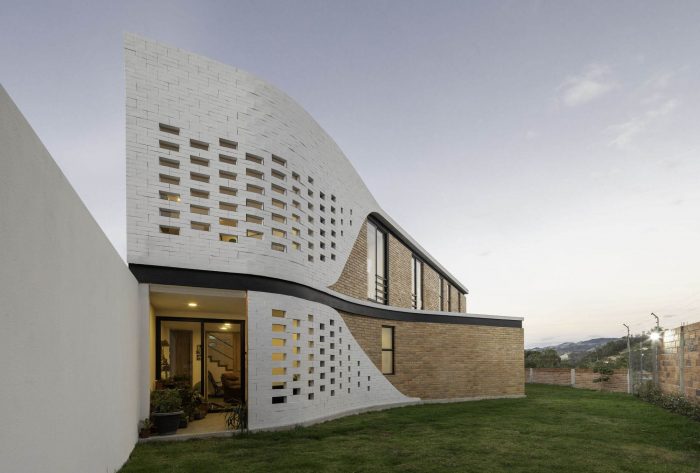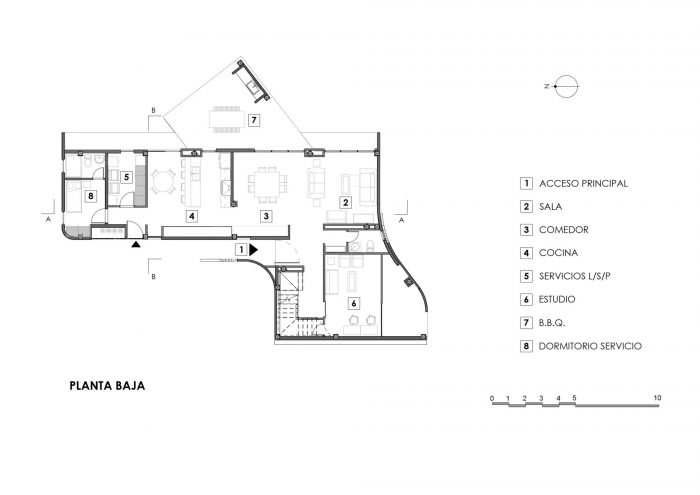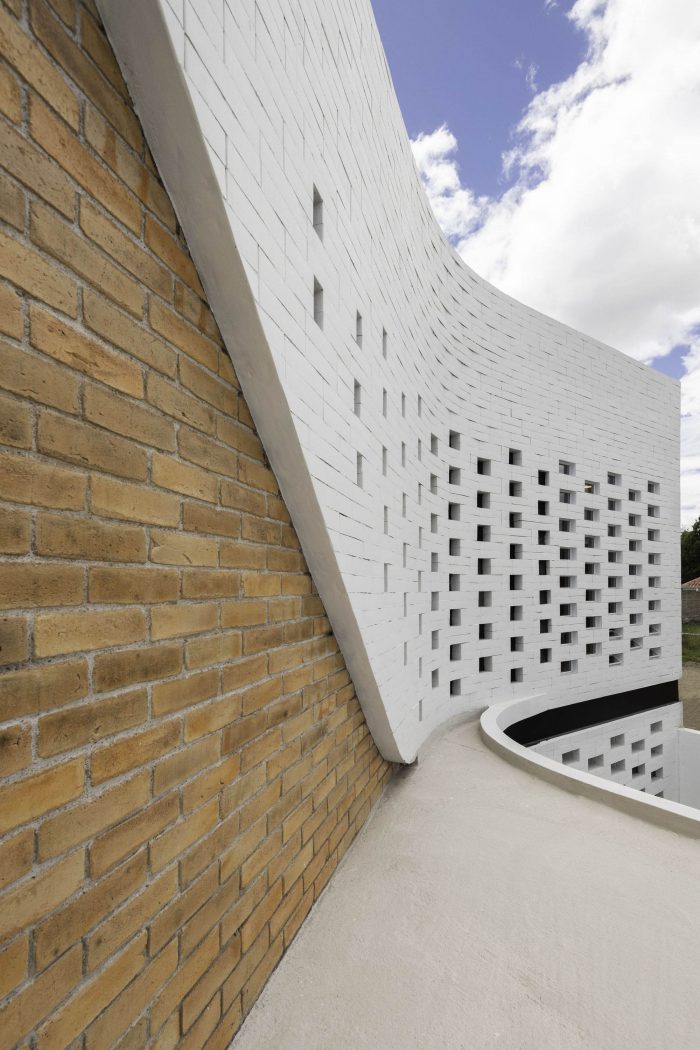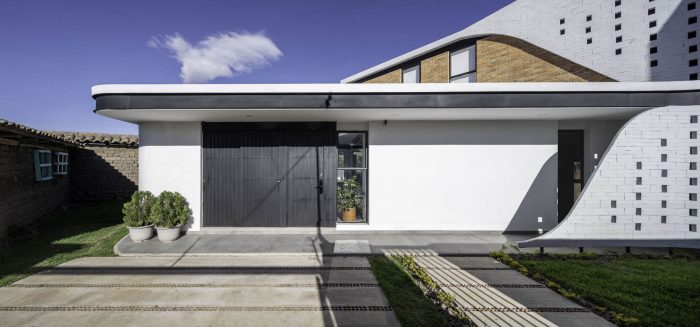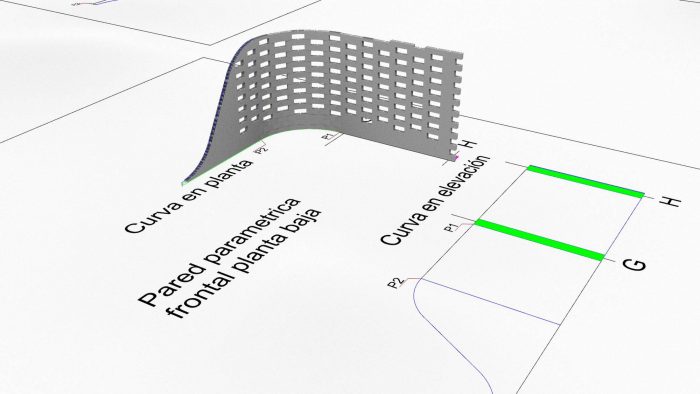目前,建筑设计过程受到三维建模和计算机辅助制造工具的强烈影响和特点,这促进了对一系列新的形式、功能和结构配置的探索,其在当前建筑中的影响是非常宝贵的,因为它将建筑转变为一个互动的、非线性的和复杂的过程。
Architectural design processes are currently strongly influenced and characterized by the use of 3D modeling and computer-aided manufacturing tools, which has facilitated the exploration of a new series of formal, functional, and structural configurations whose impact within current architecture is invaluable, as it transforms it into an interactive, non-linear and complex process.
通过使用某些参数化的设计技术,今天可以探索从一个基本参数家族中创造几何体,并了解它们之间形式关系的编程。可以生成具有变化和适应多种要求或特定标准的形式。在这个前言下,房子K探索了配置一种专门为这所房子创建的砖块的可能性;这种砖块内部有孔,重量轻,四面无接缝,并允许通过其孔用钢棒加固,以符合建筑抗震的苛刻规定。
Through the use of certain parametric design techniques, today it is possible to explore the creation of geometries from a family of basic parameters and to understand the programming of the formal relationships between them. Forms can be generated that have the ability to vary and adapt to multiple requirements or specific criteria. Under this preamble, House K explores the possibilities of configuring a brick created specifically for this house; a brick with holes in the interior, of low weight, without joints on its 4 sides, and that allows through its holes the reinforcement with steel rods to comply with the demanding regulations of earthquake resistance in construction.
应用的参数非常简单。首先是 弯曲的线条定义了房屋的两个体量 在夹层的水平上分岔行驶 并分别定义了它们的体量轮廓。第二:逐渐缩小的开口,并在墙体的所有表面横向和纵向分布。第三:砖块的大小和特殊性。第四:砖中有钢筋的位置。第五:源于夹层的升、降曲线,构成两层屋面檐口的线条。第六:风的方向,以利用交叉通风,最后,太阳在墙壁的东西面的入射,以实现室内的热舒适度,充分的光照和光影的质感在其空间。
The applied parameters were quite simple. First: The curved lines that define the two volumes of the house that at the level of the mezzanine bifurcate to travel and define separately the contour of their volumes. Second: The openings that progressively reduce their size and are distributed horizontally and vertically on all the surfaces of the walls. Third: The size and particularity of the bricks. Fourth: The place of reinforcement with steel in the bricks. Fifth: The ascending and descending curves that originate from the mezzanines and make up the lines of the eaves of the roofs of both floors. Sixth: The direction of the wind to take advantage of cross-ventilation, and finally, the incidence of the sun on the east-west faces of the walls in order to achieve thermal comfort inside, adequate lighting and textures of light and shadow in their spaces.
值得一提的是,客户的参与对这所房子至关重要,因为他们给了我们必要的信心,让我们用这些复杂的、非传统的CAD系统进行设计,否则这是不可能的,有了他们的参与,房子的内部和外部空间都按照他们的要求逐一配置,使他们的居住性按照他们的要求进行。这个设计的有趣之处在于,将砖这种传统材料与Rhino等先进的软件结合起来,进行数字化设计和规划;通过传统的砖墙与砂浆、钢筋的施工体系,在不取代当地劳动力的情况下,通过模板、精密计划、系统验证等特殊工具的一些辅助,达到最终的效果,实现了施工、物化或向真实平面的过渡。
It is important to mention that the participation of the clients in this house was of vital importance, as they gave us the necessary confidence to carry out the design with these CAD systems of complex, non-traditional ideation, which otherwise would not have been possible, and with them Together, the interior and exterior spaces of the house were configured one by one according to their requirements so that their habitability goes according to what they looked for. The interesting thing about this design is the use of a traditional material such as brick in conjunction with advanced software such as Rhino, for digital design and planning; and the construction, materialization, or transition to the real plane, through a traditional construction system of brick walls with mortar and steel rods, without displacing the local labor force, but with some assistance from special tools such as templates, precision plans, and systems verification, to achieve the final result.
砖是最古老的建筑产品之一,至今仍有较为广泛的应用,然而,随着时间的推移,甚至在拉丁美洲的背景下,使用这种材料的施工过程并没有发生很大的变化,因为施工系统和配置砖石的可能性是我们都已经知道的,然而,通过使用先进的数字构思系统,路易斯-卡恩的名言已经被付诸实践。”即使是一块普通的砖头… 也想成为比它更多的东西” 在这个国家,由于高成本的原因,数字化制造还不是一个选择,让位于复杂配置的元素设计是一个挑战,而我们House K已经成功实现了。简单的事实是将92个小铝窗和玻璃窗放置在砖块空出的空间里,一个接一个,与一个合格的工匠一起,看看阳光对这些空间内部的影响,这是非常有意义的事情。
Brick is one of the oldest construction products and is still more widely used today, however, over time and even in the Latin American context the construction process with this material has not undergone great variations, since the construction system and the possibilities for configuring masonry are those that we all already know, however, through the use of advanced digital ideation systems, the famous phrase of Louis Kahn has been put into practice: “Even a common, ordinary brick … wants to be something more than it is “. In a country where digital manufacturing is not yet an option due to the high costs that this implies, giving way to the design of elements with complex configurations was a challenge that we at House K have managed to achieve. The simple fact of having placed the 92 small aluminum and glass windows in the spaces that the bricks leave free in the walls, one by one, with a qualified craftsman of the place, and see what the sunlight does to the interior of those spaces, it was something very rewarding.
建筑师: Creative Union Network
面积:325平方米
年份:2020年
照片:Nicolás Provoste Fotografía
首席建筑师:Daniel Idrovo Vintimilla
设计团队:Daniel Idrovo Vintimilla、David Bustillos、Karla Mogrovejo和María Inés Ochoa
客户:Familia Vintimilla-Duque
结构工程:Alberto Vásquez
电气:Fabián Aucapiña
MEP:Johanna Urigüen
视觉效果:Daniel Villa
合作者:Richard Villacorta、Simón Ruiz、Paul Alvarez、Manuel Lojano
国家:厄瓜多尔
Architects: Creative Union Network
Area: 325 m²
Year: 2020
Photographs: Nicolás Provoste Fotografía
Lead Architects:Daniel Idrovo Vintimilla
Design Team:Daniel Idrovo Vintimilla, David Bustillos, Karla Mogrovejo y María Inés Ochoa
Clients:Familia Vintimilla-Duque
Structural Engineering:Alberto Vásquez.
Electrical:Fabián Aucapiña
MEP:Johanna Urigüen
Visualisation:Daniel Villa
Collaborators:Richard Villacorta, Simón Ruiz, Paul Alvarez, Manuel Lojano.
Country:Ecuador


